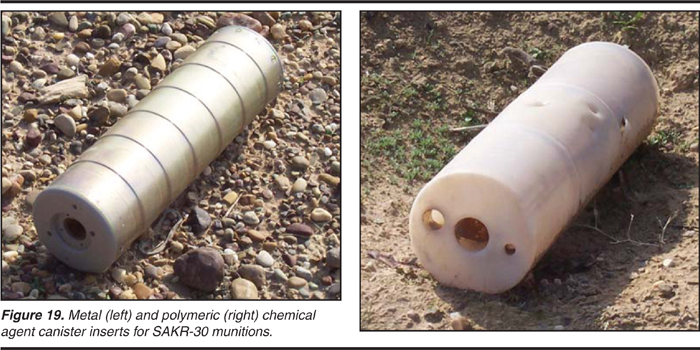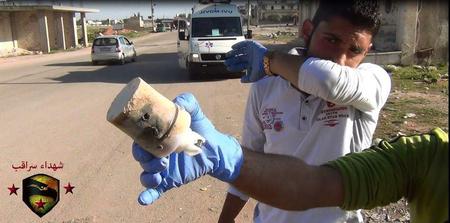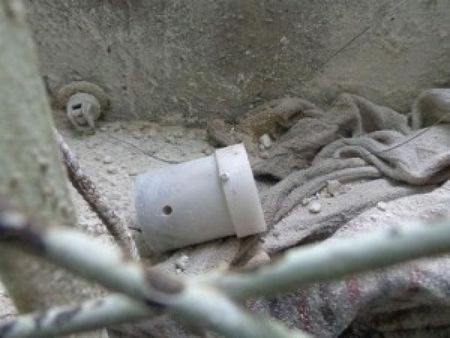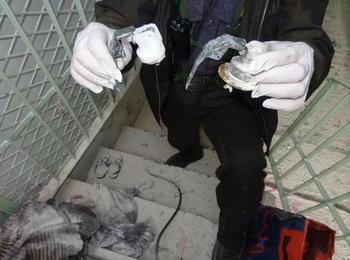Syria Analysis: Chemical Weapons Attack --- Is This Plastic Canister A Vital Clue?
Update: A new video (above) of the canister that allegedly carried a cehmical weapon in Saraqib.
On Monday, opposition activists, members of the Free Syrian Army, and residents reported another chemical weapons attack in Syria. The reports said that the town of Saraqib, in Idlib province, an opposition stronghold in between Idlib province's two main battlefields (map) had been attacked from Assad aircraft, and victims on the ground were being treated for symptoms related to the inhalation of a noxious chemical gas.
This is one of the videos posted by an account closely tied to Saraqib and Aleppo. The video was also posted by the Local Coordination Committees. At the start of the video, incoming projectiles, likely bomblets from a cluster bomb, can be seen. After this, the video shows alleged victims of the chemical weapon attack:
Often, the only evidence that is available immediately following these claimed attacks are videos of the reported victims and the doctors who treat them.
For a variety of reasons, those videos alone have not been sufficient to diagnose what, if any, chemical agent may have been used. Soil, blood, or tissue samples would be required, but as the United States government pointed out, in those cases the "chain of custody" is also important.
In other words, it is possible to test physical samples for chemical agents, but those samples could easily be tampered with or contaminated, raising doubt about whether any detected chemicals came from a chemical weapons attack.
To determine beyond reasonable doubt whether a chemical agent has been used, an objective third party such ashe United Nations needs to investigate the situation on the ground. However, the Assad has blocked UN teams from entering the country.
However, a video taken yesterday of a small piece of plastic, burned up deep inside Syria's warzone, may actually be a vital clue as to whether forces loyal to Assad have used chemical weapons.
The footage shows several men removing a canister from a trash bag. They say it was dropped on their town and contained a chemical gas (the video goes on to show some of the victims in a field hospital). A screenshot is below.
Usually, this wouldn't be much to go on. However, a keen-eyed observer, Eliot Higgins, recognized this canister. It matches precisely a canister found at the scene of another alleged chemical weapons attack on April 13th in Sheikh Maqsoud in Aleppo city (map). The picture below is one of several taken after the Sheikh Maqsoud incident, and the rest can be seen on Higgins's blog.
It's a perfect match, except that the top of the canister, the fuze mechanism or cap, has been knocked or blown off in the Aleppo incident. Even then, however, it matches the cap in the video from Saraqib.
These small apparently plastic cannisters were found at the sites of alleged chemical weapons attacks. So it is worth investigating the possibility that they are the device or part of the device that actually released the chemical agent.
So what are these cannisters? At this hour, thanks to the work of EA and Eliot Higgins, there are teams of arms experts trying to answer that very question.
Here is what we know about the device so far. We contacted a specialist in industrial chemistry, who told us that they have seen plenty of housings somewhat similar to this, but for industrial use.
The material is likely polypropylene, though it may also be polytetrafluoroethylene or (least likely) polyester - a polymer, anyway. As Michael Weiss points out, the casing is analogous to a chemical-weapons delivery system used by Saddam Hussein in a SAKR-30 122mm rocket launcher, though there are clearly differences.
However, this is proof that a casing with some similarities, made out of a polymer, has been used before to deliver chemical agents.
 https://www.cia.gov/library/reports/general-reports-1/iraq_wmd_2004/chap5_annxB.htmlThere is another feature, however. The fuze mechanism, or cap, shares some characteristics with another known submunitions, DPICMs:
https://www.cia.gov/library/reports/general-reports-1/iraq_wmd_2004/chap5_annxB.htmlThere is another feature, however. The fuze mechanism, or cap, shares some characteristics with another known submunitions, DPICMs:
http://goo.gl/AzPn6In another picture from a gallery of the Sheikh Maqsoud incident, however, the cap appears more grenade-like:
So far, we have scoured the internet for a picture that can identify these devices, as have experts we've contacted. The two devices seen here do not match any known canister we've found so far. That could mean that whatever this is, it was custom manufactured for this purpose. Our chemical industry expert suggests that this would be very easy to do.
We do know, however, what this is not. This canister is almost certainly not a smoke or teargas grenade. There are mass-produced weapons for both of those purposes that would be far more reliable than a prototype only used by Syria.
Furthermore, smoke grenades burn above the melting point of most polymers. Teargas could be used with a metal container as it is not corrosive. The temperature factor also rules out any sort of incendiary agent.
Could this cannister have been used to disperse a chemical agent?
The industrial chemistry expert we consulted suggests that this is possible. If the cap was designed as an aerosol, or even if it just blew off on impact or opened in the air, chemical agents, possibly in liquid form, would be dispersed at relatively high altitudes. The vapor and fumes would then disperse over a relatively wide area, creating a relatively diffuse chemical attack. The important thing is that the specific mechanism of the attack, as well as the traces of the chemical left on the device, could easily be assertained if experts could get hold of these canisters.
It should be noted that some have noted that the device bears some resemblance to a grenade. One would think that it would be unwise to design a grenade to disperse chemical weapons such as this, however, but that mystery remains.
We're still looking to identify this canister, but it may be the key to understanding more about the on-the-ground reports of chemical weapons use in Syria.
Attacks Forming a Pattern
The locations of each claimed chemical weapons attack do not appear to be a coincidence. The reports are coming from near the front lines, in areas near key rebel supply lines.
In Khan al Asal, Aleppo, the rebels claim the attack was a mistake made by the regime as it tried to target the rebel front lines.
That area is the main route of advance for some significant rebel firepower, including many artillery pieces that jhave targeted Assad's main bases in Aleppo city. At nearly the exact same time as that alleged incident occurred, there were claims of a chemical attack in Otaybah, east of Damascus. That town was important enough to Assad that he may have sacrificed more than a dozen (perhaps more than two dozen) tanks, and about three weeks of fighting time, to capture.
Last week there was a report of an attack in Darayya, an area that has been under constant attack by the regime for more than 6 months.
On April 13th, reports came through of an alleged chemical attack on Sheikh Maqsoud, the key supply line and rebel base for a massive offensive to capture the northeastern districts of Aleppo.
The latest allegations come from Saraqib, a key point between regime bases near Ma'arrat al Nouman, Idlib city, and about 36 kilometers west of the Abu Duhor military airport which has been under attack and may have fallen to Syrian rebels today.
The pattern is clear.
Questions Remain
We have not identified the canister. We have yet to link, with 100% certainty, that the objects seen dropping from aircraft are the canisters. There are no soil, blood, or tissue samples where the chain of custody is airtight. There is no smoking gun. However, there is plenty of information here for experts to examine and potentially reach a conclusion.
There is also another possibility. Activists report that they tried to evacuate the victims of this incident to Turkey, but they could not because they did not possess the proper ambulances. If the victims, or even these canisters, can find their way out of the country and into Turkish or UN hands, the mystery could be solved.
 Chemical Weapons,
Chemical Weapons,  Darayya,
Darayya,  Idlib,
Idlib,  Khan al Asal,
Khan al Asal,  Otaybah,
Otaybah,  Saraqib,
Saraqib,  Sheikh Maqsoud,
Sheikh Maqsoud,  Syria
Syria 



Reader Comments